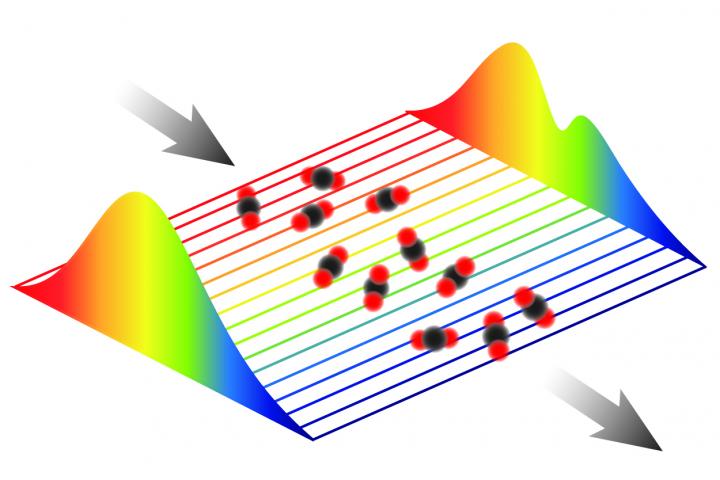A laser that smells like a hound

This is a graphic describing a laser comb measuring the light absorption patterns of carbon dioxide molecules. Credit: Sarah Scholten Usage Restrictions: For use with this story only
Applications for the new device lie not just in environmental monitoring and detecting industrial contamination, but may eventually be used to diagnose disease by “smelling” the breath.
The researchers liken the ability of the laser to differentiate between different gas compounds in a sample to the sensitive nose of a bloodhound. But rather than smell, the device uses patterns of light absorption to measure the composition of the sample.
From the University's Institute for Photonics and Advanced Sensing (IPAS), the researchers report in the journal Physical Review Applied that the laser can measure the amount of carbon dioxide in a gas sample in under one second, with high accuracy and precision.
“The ability to rapidly measure gas composition to such high accuracy is cutting edge,” says lead author Sarah Scholten, PhD candidate in the University's School of Physical Sciences. “With further development, it opens the way for real-time and inexpensive monitoring and analysis that can be carried out in the field, or in the doctor's surgery, by non-specialist operators.”
The device exploits a Nobel-prize winning technology, developed by US and German scientists, called an 'optical frequency comb'. This 'laser comb' generates millions of different light frequencies or colours at once.
The researchers pass this special light through a sample of gas where each gas molecule absorbs a distinctive set of colours. The pattern of light absorption is a unique fingerprint of the gas composition of the sample.
“This first work aims at atmospheric monitoring, however, the technique is broadly applicable and offers an avenue for near-universal concentration measurements,” says Dr Chris Perrella, Postdoctoral Fellow.
The group now aims to use the laser comb to unravel the chemical composition of the exhaled breath – in this much more complex situation they hope to find tell-tale chemical signs that point to underlying disease. The ultimate goal is to use the laser as a screening tool – to discover a serious illness even before the patient is aware of the condition.
###
The research was led by IPAS Director Professor Andre Luiten and was funded by the Australian Research Council, Medical and Scientific Services Pty Ltd, the South Australian Premier's Research and Industry Fund and a South Australian Government Catalyst Research Grant.
Media Contact:
Sarah Scholten, PhD candidate, School of Physical Sciences, The University of Adelaide. Mobile: +61 (0)401 857 960, sarah.scholten@adelaide.edu.au
Professor Andre Luiten, IPAS Director, The University of Adelaide, Phone: +61 (0)8 8313 2359, Mobile: +61(0) 404 817 168, andre.luiten@adelaide.edu.au
Dr Chris Perrella, Postdoctoral Fellow, Institute for Photonics and Advanced Sensing, The University of Adelaide. Phone: +61 ())8 8313 2323, Mobile: +61 (0)424 544 035, chris.perrella@adelaide.edu.au
Robyn Mills, Media Officer, University of Adelaide. Phone: +61 (0)8 8313 6341, Mobile: +61 (0)410 689 084, robyn.mills@adelaide.edu.au
Media Contact
More Information:
http://dx.doi.org/10.1103/PhysRevApplied.9.054043All latest news from the category: Physics and Astronomy
This area deals with the fundamental laws and building blocks of nature and how they interact, the properties and the behavior of matter, and research into space and time and their structures.
innovations-report provides in-depth reports and articles on subjects such as astrophysics, laser technologies, nuclear, quantum, particle and solid-state physics, nanotechnologies, planetary research and findings (Mars, Venus) and developments related to the Hubble Telescope.
Newest articles

Webb captures top of iconic horsehead nebula in unprecedented detail
NASA’s James Webb Space Telescope has captured the sharpest infrared images to date of a zoomed-in portion of one of the most distinctive objects in our skies, the Horsehead Nebula….

Cost-effective, high-capacity, and cyclable lithium-ion battery cathodes
Charge-recharge cycling of lithium-superrich iron oxide, a cost-effective and high-capacity cathode for new-generation lithium-ion batteries, can be greatly improved by doping with readily available mineral elements. The energy capacity and…

Novel genetic plant regeneration approach
…without the application of phytohormones. Researchers develop a novel plant regeneration approach by modulating the expression of genes that control plant cell differentiation. For ages now, plants have been the…





















